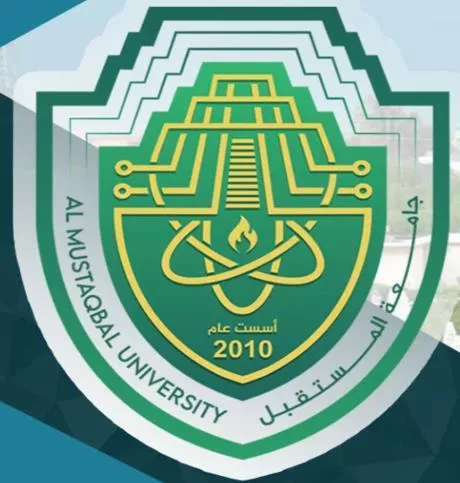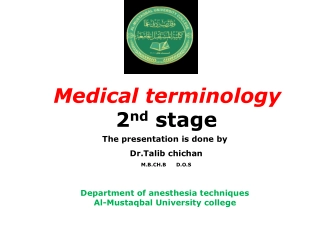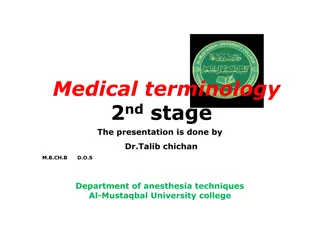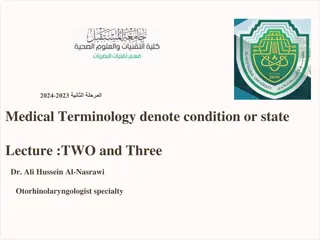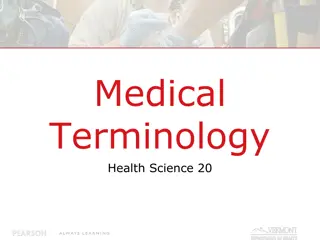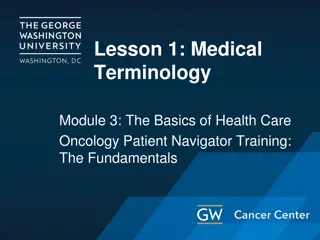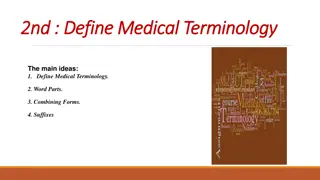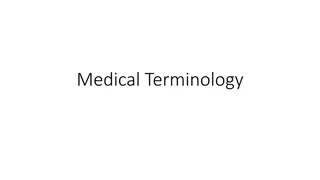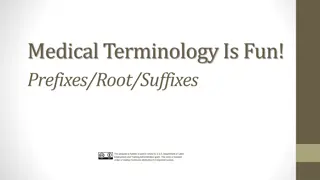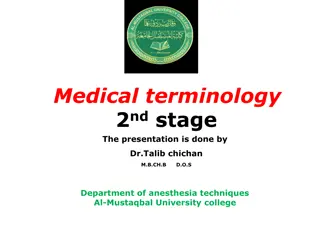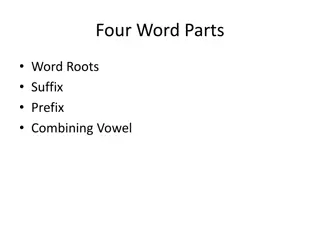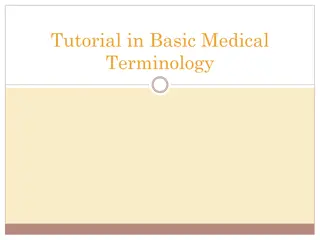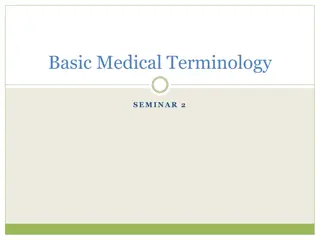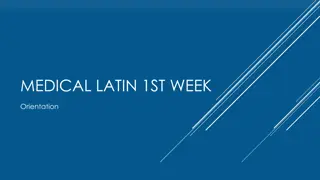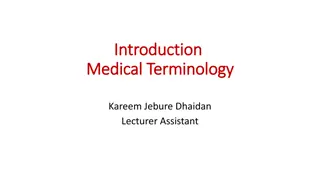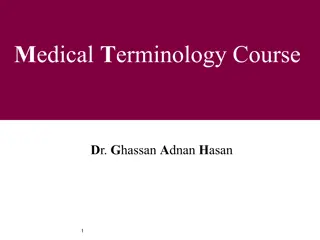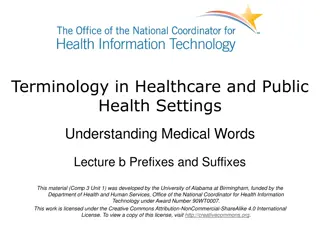Medical Terminology
Medical terminology denotes various medical actions crucial for effective communication in healthcare settings. Understanding suffixes and different types of medical terminology can aid medical students, professionals, and patients in interpreting medical records, communicating clearly, and making informed healthcare decisions. Learn about terms denoting surgical, diagnostic, and therapeutic procedures, enhancing your grasp of medical language and improving patient education.
Download Presentation

Please find below an Image/Link to download the presentation.
The content on the website is provided AS IS for your information and personal use only. It may not be sold, licensed, or shared on other websites without obtaining consent from the author.If you encounter any issues during the download, it is possible that the publisher has removed the file from their server.
You are allowed to download the files provided on this website for personal or commercial use, subject to the condition that they are used lawfully. All files are the property of their respective owners.
The content on the website is provided AS IS for your information and personal use only. It may not be sold, licensed, or shared on other websites without obtaining consent from the author.
E N D
Presentation Transcript
2024 - 2023 Medical Terminology Lecture :4thMedical Terminology Denotes Medical Actions Dr. Ali Hussein Al-Nasrawi Otorhinolaryngologist specialist
Medical Terminology Denotes Medical Actions Medical terminology is the language used by healthcare professionals to communicate with each other and with their patients. It is important for medical students to learn medical terminology so that they can understand and interpret medical records, communicate effectively with their colleagues and patients, and document their own findings and assessments. One way to learn medical terminology is to focus on suffixes. Suffixes are added to the end of words to change their meaning. In medical terminology, suffixes are often used to denote medical actions.
Introduction Medical terminology denoting medical actions are the medical terms that describe procedures performed on the patient or body. These terms are often composed of Greek or Latin roots that indicate the literal meaning. Medical terminology denoting medical actions is important for effective communication between healthcare professionals and patients. This terminology allows doctors, nurses, and other healthcare practitioners to describe and understand medical procedures accurately. Patients can also benefit from understanding medical terminology denoting medical actions. This can help patients to understand what is happening to them during medical treatment and to make informed decisions about their healthcare.
III-Types of medical terminology denoting medical actions: Medical terminology denoting medical actions can be divided into several categories, including: o Terms denoting surgical procedures: such as "surgery", "operation", and "procedure". o Terms denoting diagnostic procedures: such as "examination", "test", and "imaging". o Terms denoting therapeutic procedures: such as "therapy", "medication", and "intervention".
IV-Examples of medical terminology denoting medical actions Terms denoting surgical procedures: Surgery: A medical procedure in which a cut is made in the body. Operation: A medical procedure performed under general or local anesthesia. Procedure: A medical procedure performed without making a cut in the body. Terms denoting diagnostic procedures: Examination: A physical examination performed by a doctor to look for any signs or symptoms of disease. Test: A test performed to determine the cause of a disease or injury. Imaging: A procedure used to create images of the inside of the body, such as X-rays, MRI, and CT scans. Terms denoting therapeutic procedures: Therapy: A medical treatment used to treat a disease or injury. Medication: A drug used to treat a disease or injury. Intervention: A medical procedure performed to prevent or treat a disease or injury.
V-Importance of understanding medical terminology denoting medical actions: Medical terminology denoting medical actions is important for the following reasons: It allows healthcare professionals to communicate effectively with each other and with patients. It enables patients to understand what is happening to them during medical treatment and to make informed decisions about their healthcare. It is essential for medical students and healthcare workers to learn in order to provide safe and effective care.
VI-Examples of specific medical terminology denoting medical actions Cardiac catheterization Cardiac catheterization is a procedure in which a thin tube is inserted into a blood vessel and threaded through the heart. This procedure can be used to diagnose and treat heart conditions, such as coronary artery disease, valvular heart disease, and heart failure.
VII- Appendectomy An appendectomy is a surgical procedure to remove the appendix. The appendix is a small finger-shaped organ that projects from the large intestine. Appendectomy is typically performed to treat appendicitis, which is an inflammation of the appendix.
VIII- Colonoscopy A colonoscopy is a procedure in which a thin, flexible tube with a camera on the end is inserted into the rectum and threaded through the colon. This procedure can be used to diagnose and treat colon cancer, polyps, and other conditions of the colon.
IX- Mammography A mammogram is an X-ray of the breast. Mammography is used to screen for breast cancer in women over the age of 40.
X - MRI : Magnetic resonance imaging (MRI) is a procedure that uses a strong magnetic field and radio waves to create detailed images of the inside of the body. MRI can be used to diagnose a wide range of conditions, including brain tumors, spinal cord injuries, and ligament tears.
XI- CT scan Computed tomography (CT) scan is a procedure that uses X-rays to create detailed images of the inside of the body. CT scans can be used to diagnose a wide range of conditions, including cancer, heart disease, and stroke.
Other examples of medical terminology denoting medical actions Angiography Arthroscopy Cesarean section Electrocardiogram (EKG) Electromyogram (EMG) Gastroscopy
Appendectomy An appendectomy is a surgical procedure to remove the appendix. The appendix is a small finger-shaped organ that projects from the large intestine. Appendectomy is typically performed to treat appendicitis, which is an inflammation of the appendix. appendectomy
Nebulization Physical therapy Radiation therapy Ultrasound
Incision: The act of cutting into tissue. Common medical terms related to incisions include: Incision: A cut made in the body during surgery. Excision: The complete removal of tissue, often including a tumor or lesion. Resection: The partial removal of an organ, tissue, or structure. For example: Lobar resection: Removal of a specific lobe of an organ such as a lung or liver
-centesis: puncture -centesis: thoracentesis (puncture of the chest wall to remove fluid), lumbar puncture (puncture of the spine to remove cerebrospinal fluid)
-plasty: repair or reconstruction rhinoplasty -plasty: creation of a new structure -plasty: replacement of a structure -plasty: transfer of a structure -plasty: widening of a structure -plasty: narrowing of a structure knee arthroplasty
3-Biopsy: The removal of a small piece of tissue for examination. Types of biopsies include: Excisional biopsy: The complete removal of tissue, often including a tumor or lesion. Needle biopsy: Using a thin needle to obtain a tissue sample. Removing an entire lump or suspicious tissue. Incisional biopsy: Taking a small piece of a larger tissue mass.
4-Amputation: The surgical removal of a limb or part of a limb. Terms related to amputation include: Above-knee amputation (AKA): Removal of the leg above the knee. Below-knee amputation (BKA): Removal of the leg below the knee
Reconstruction: The process of restoring or reshaping a body part. This can involve procedures such as: Plastic surgery: Surgery for aesthetic or reconstructive purposes. Reconstructive surgery: Restoring the form or function of a damaged or missing body part. Transplantation: The surgical transfer of an organ or tissue from one person to another. Common transplant procedures include: Kidney transplantation: Replacing a damaged or nonfunctional kidney with a healthy one. Heart transplantation: Replacing a failing heart with a donor heart. Ablation: The removal or destruction of tissue, often using heat or cold. Examples include: Radiofrequency ablation: Using heat to destroy cancerous tissue. Cryoablation: Using cold to freeze and destroy abnormal tissue.
Anastomosis: The surgical connection of two structures, such as blood vessels or sections of the intestine. Gastrointestinal anastomosis: Joining two parts of the digestive tract, often after a resection. Suturing: The act of sewing together tissue, typically with stitches. This includes: Interrupted sutures: Individual stitches used to close a wound. Continuous sutures: A single, continuous stitch used to close a wound. Ligation: The process of tying off or closing a blood vessel, duct, or other structure. Tubal ligation: A surgical procedure for female sterilization by tying or sealing the fallopian tubes.
Endoscopy: A procedure that involves examining the interior of a body cavity or organ using a thin, flexible tube with a camera. Colonoscopy: Examining the colon. Gastroscopy: Examining the stomach. These are just a few examples of medical actions and the associated terminology used in the medical field. The terminology helps medical professionals communicate clearly and accurately about various procedures and treatments.
Medical terms denoting therapeutic procedures such as : therapy, medication, and intervention include: Therapy: Any treatment intended to improve a person's physical, emotional, or cognitive well-being. Examples of therapy include :physical therapy, occupational therapy, speech therapy, and cognitive-behavioral therapy. Medication: A substance used to treat, prevent, or cure a disease or condition. Medications can be taken orally, injected, or applied to the skin. Intervention: A medical procedure or treatment that is performed to prevent or treat a disease or condition. Examples of interventions include : surgery, radiation therapy, and chemotherapy.
Here are some examples of specific medical terms denoting therapeutic procedures: Physical(physiotherapy) therapy: A type of therapy that helps people recover from injuries or improve their physical function. Occupational therapy: A type of therapy that helps people learn or relearn the skills they need to live independently and perform their daily activities. Speech therapy: A type of therapy that helps people improve their speech and communication skills. Cognitive-behavioral therapy (CBT): A therapy that helps people identify and change negative thoughts and behaviors. Medication: Drugs such as antibiotics, antidepressants, and painkillers. Surgery: A medical procedure that involves cutting into the body to repair or remove damaged tissue. Radiation therapy(Radiotherapy): A type of cancer treatment that uses high-energy radiation to kill cancer cells. Chemotherapy: A type of cancer treatment that uses drugs to kill cancer cells. It is important to note that these are just a few examples of medical terms denoting therapeutic procedures. There are many other medical terms that can be used to describe different types of therapies, medications, and interventions.




